Share
PART V: The Indian Army hockey tour of New Zealand 1926
Field Marshall William Riddell Birdwood, Commander in Chief in India (1925–1930), who had commanded the Australian and New Zealand Army Corps (ANZAC) for much of the First World War, facilitated the Indian Army Hockey Team tour of New Zealand in 1926. Birdwood had toured Australia and New Zealand in 1920 to wide public acclaim.
The New Zealand Hockey Association (NZHA) and the Army Sports Control Board started the process of arranging a tour in late 1924. Newspapers in New Zealand reported in December 1924 that “An Indian hockey team (of Englishmen and Sikhs) will probably visit New Zealand next season”.
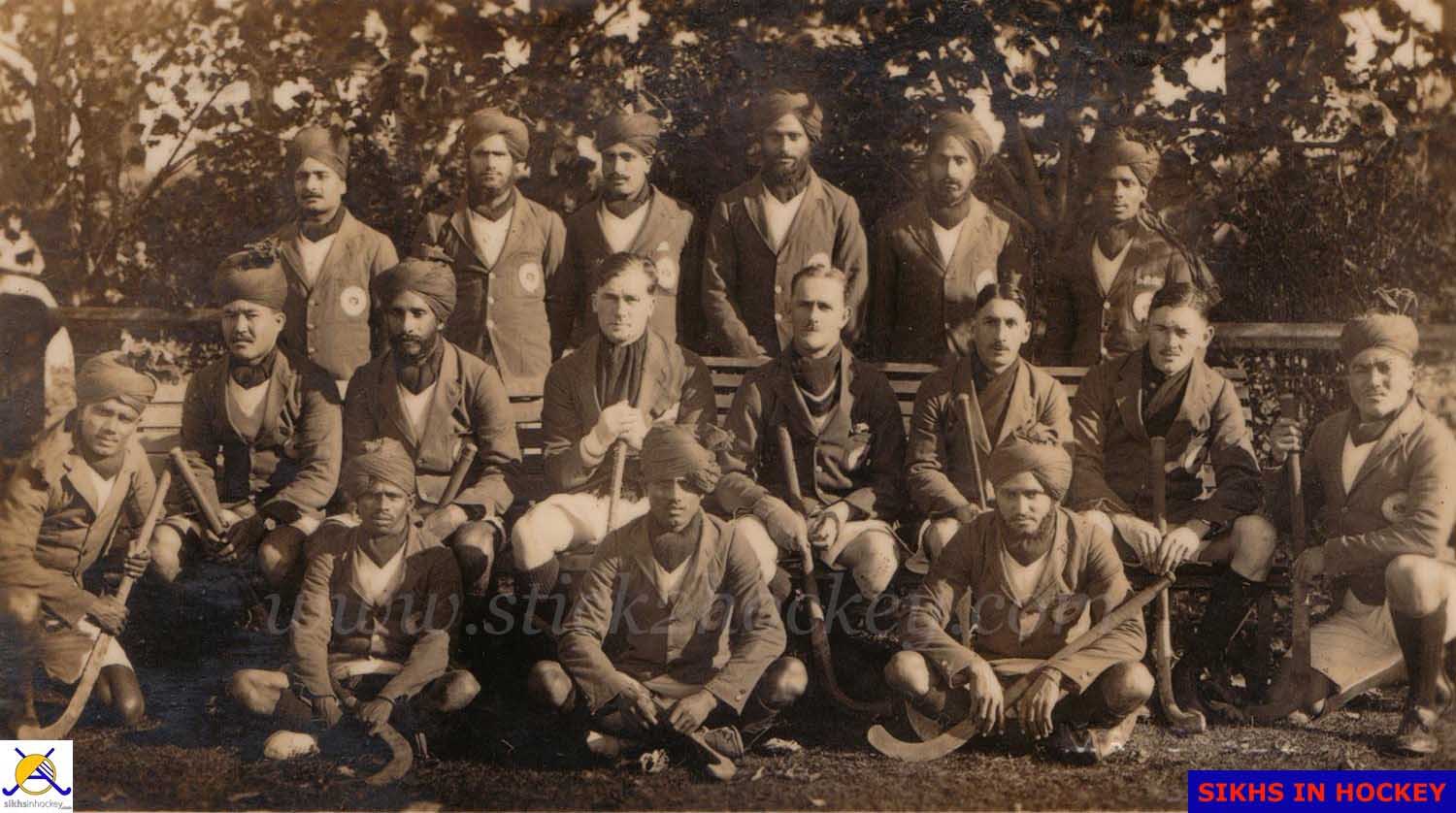
Indian Army Hockey Team in New Zealand 1926. Photo; Photo: Thakar Singh family collection
In early 1925, the team was officially invited by NZHA to tour New Zealand. This tour was planned well before the Indian Hockey Federation was formed.
Once the invitation to tour was accepted preliminary trials were held at Rawalpindi during the Army Hockey Championship and at Jhelum during the Punjab Native Army Hockey Tournament. The selected players were sent down to Lahore, where the final choices were made by Colonel Bruce Turnbull, Captain Cowan and Mr Ritchie (who was the coach of the Punjab team).
The Punjab Provincial team beat the India Army team 5-2 just prior to its departure for New Zealand.
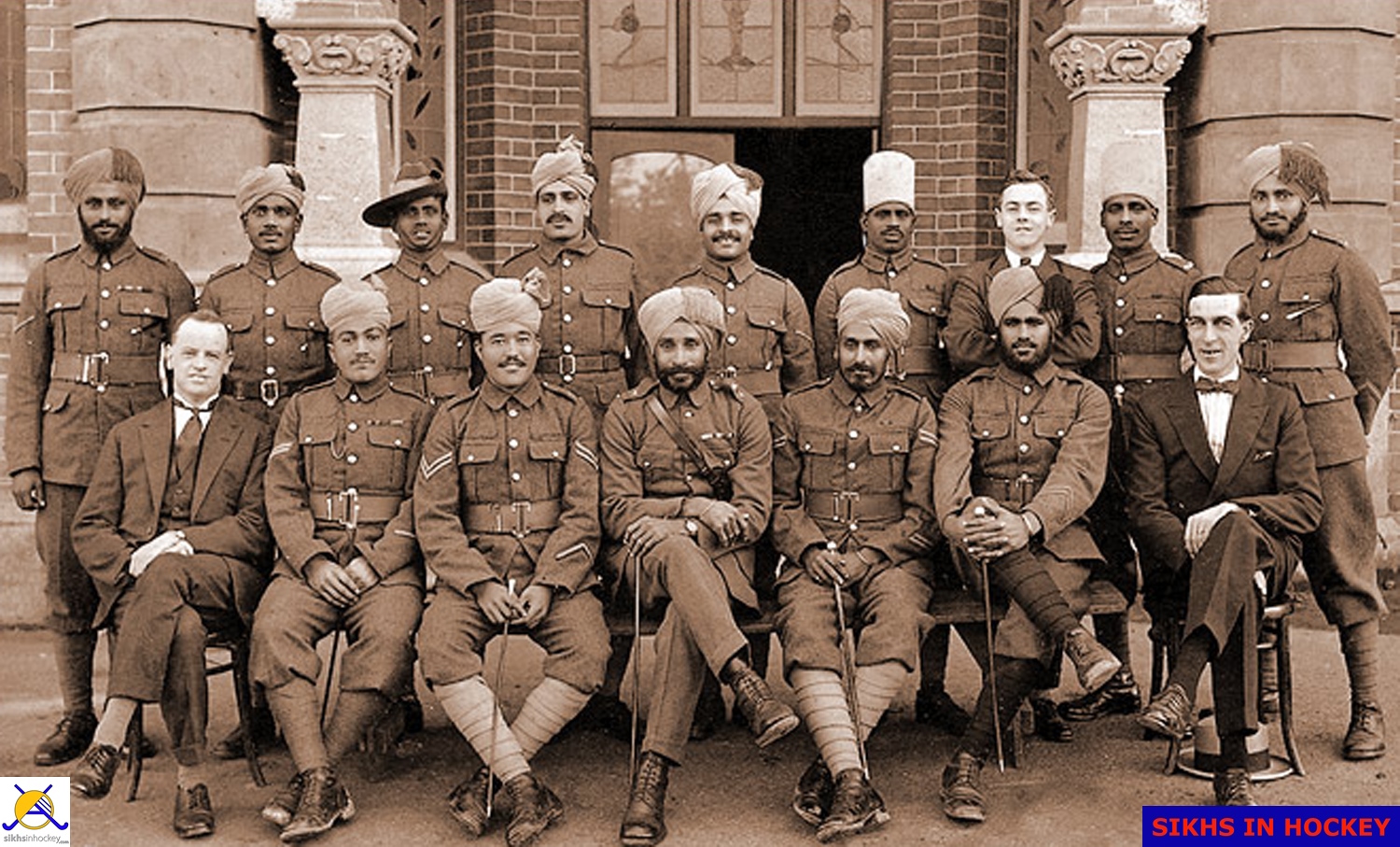
Indian Army Hockey Team in New Zealand 1926. Photo: Thakar Singh family collection
The selected touring team announced on 4 March 1926 was:
1. Captain D. T. Cowan MC (captain) (1st Battalion, 6th Gurkha Rifles)
2. Captain H. V. Cox (2nd Battalion, 8th Punjab Regiment)
3. Captain E. A. Belchamber (1st Battalion, 11 Sikh Regiment)
4. Captain L A Alexander (1st Battalion, 5th Royal Gurkha Rifles)
5. Jemadar Lal Singh 92nd Battalion, 8th Punjab Regiment)
6. Naik Ghulan Ali (1st Battalion, 4th Hazara Pioneers)
7. Naik Thakar Singh (1st Battalion, 4th Prince of Wales’s Own Gurkha Rifles)
8. Naik Lal Shah (1st Battalion, 4th Hazara Pioneers)
9. L/Naik Dhian Singh (2nd Battalion, 8th Punjab Regiment)
10. L/Naik Susai Nathan (Queen Victoria’s own Madras Sappers and Miners)
11. L/Naik Kishana Singh (2nd Battalion, 17th Dogra Regiment)
12. Sepoy Manu Swami (Queen Victoria’s own Madras Sappers and Miners)
13. Sepoy Dhyan Chand (4th Battalion, 1st Punjab Regiment)
14. Sepoy Sangara Singh (2nd Battalion, 13th Frontier Force Rifles)
15. Sepoy Jaginder Singh (2nd Battalion, 8th Punjab Regiment)
16. Fitter Fakir Chand (Royal Army Service Corps (MT)
17. Fitter H. Francis (Royal Army Service Corps (MT)
The team of 17, led by captain David Tenant Cowan MC, widely known as “Punch” Cowan, included four English officers, one Sikh officer and 12 Indian soldiers. The team assembled in Calcutta and sailed from there on Sunday, 11 April 1926, to Colombo. In Colombo, they beat a Ceylon Light Infantry team 14–1 and the Colombo Gymkhana Club 11-1.
The Indian Army Hockey team left Colombo on April 18 1926 and arrived in Melbourne, Australia, on the morning of 3 May, 1926, where they played a friendly match against Melbourne University at the University Oval ground in the afternoon. The University team was overwhelmed before the game had gone very far and the match finished with the Indian Army team lending the University team some of their men. The score was 8 – 2.
On 6 May, 1926, they beat an Australian Army team 23–1 at the Royal Military College, Duntroon before, departing for Auckland, New Zealand.
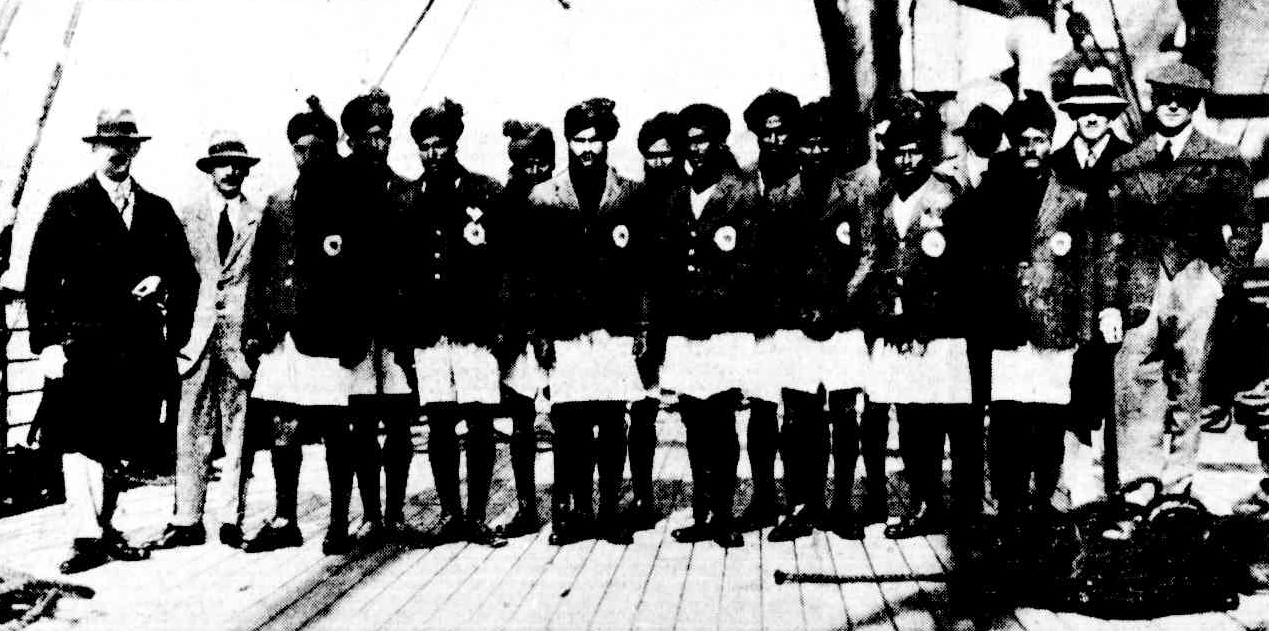
The visiting team on Chitral in Melbourne, 3 May 1926. Photo: Australian Indian Historical Society
The team arrived in Auckland, New Zealand, from Sydney on 11 May 1926.
The Indian Army team opened its New Zealand tour with an unofficial match against a Navy team in Remuera on 12 May. Expectedly, the Indian team ran out 11-1 winners.
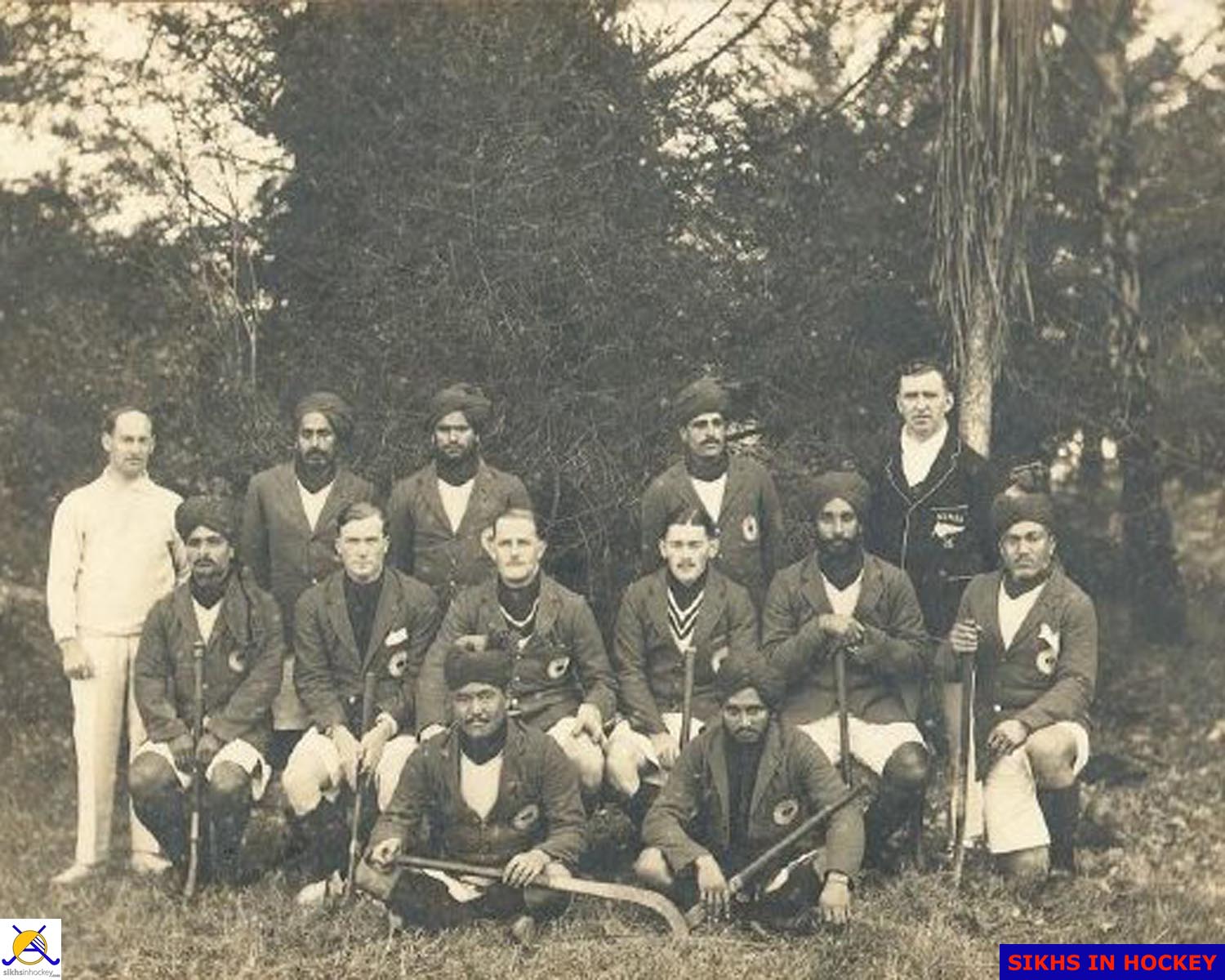
The visitors in Geraldine (NZ), 17 June 1926. Photo: Courtesy: South Canterbury Museum.
New Zealand Herald, dated 13 May, 1926, reported ‘The game can scarcely be taken as an accurate indication of the standards of hockey in India and New Zealand. Although the visitors gave a very fine exhibition they could not be expected to show their best form as they have not had time to recover from the long steamer voyage, or even to accustom themselves to New Zealand playing surfaces. The opposition, moreover, was not of the kind to produce play of a very high order. The Navy team did not reach Auckland senior club standard’.
“The opening stages of the match were quiet and the Indians took some time to settle down. After a couple of unsuccessful forward movements Dhyan Chand netted the first goal. The Navy came back a shot by Marshall bounced and beat the goalie. Expectations that the game would remain even were dispelled quickly, for the Army team added six more goals in the first spell’ The second came from a corner, Captain Cox scoring with a perfect shot after Dhyan Chand had stopped the ball for him. The visitors kept play in the Navy twenty-five and were generally dominant’.
‘Four of the goals came from the stick of Dhyan Chand, a slightly-built youth, who played a remarkable game at centre-forward. His stick work and control of the ball were well-nigh perfect, and although he was a great individualist he always knew when to pass the ball. Most of his short passes were to his inside-left, Captain Y. M. H. Cox, who, with Dhyan Chand, shared the honours in the forward line. He played correct hockey throughout and varied his play in the circle with discrimination. He will do well on the New Zealand tour. Captain Cox also scored four goals and Singara Singh the other three. The whole side played with perfect understanding’.

Official Souvenir Guide Lancaster Park 12.06.1926. Photo; Takhar Singh Family
The Army team played their first scheduled match of the tour on Thursday, 13 May when they met Waipa at TeAwumutu. There was a large attendance.
The Indian Army won the match comfortably with Cox scoring four goals, Chand three, Belchamber and Susai Nathan two goals apiece.
The team enjoyed similar successes in their next 13 matches, six of which were won with margins of double figures.
The much awaited test matches against New Zealand created a lot of interest and received a big coverage in the national and local newspapers all over New Zealand.
The match was played at Lancaster Park on a Saturday, before a crowd estimated to be over 14,000. The weather was mild, and there was no wind. The ground had been specially prepared and was in good order for a clever exhibition of stick work.
In a lively encounter, India showed the better combination and science generally while winning 5-2. The Indian Army team, playing in red shirts, white shorts and red socks, in their first international match was:
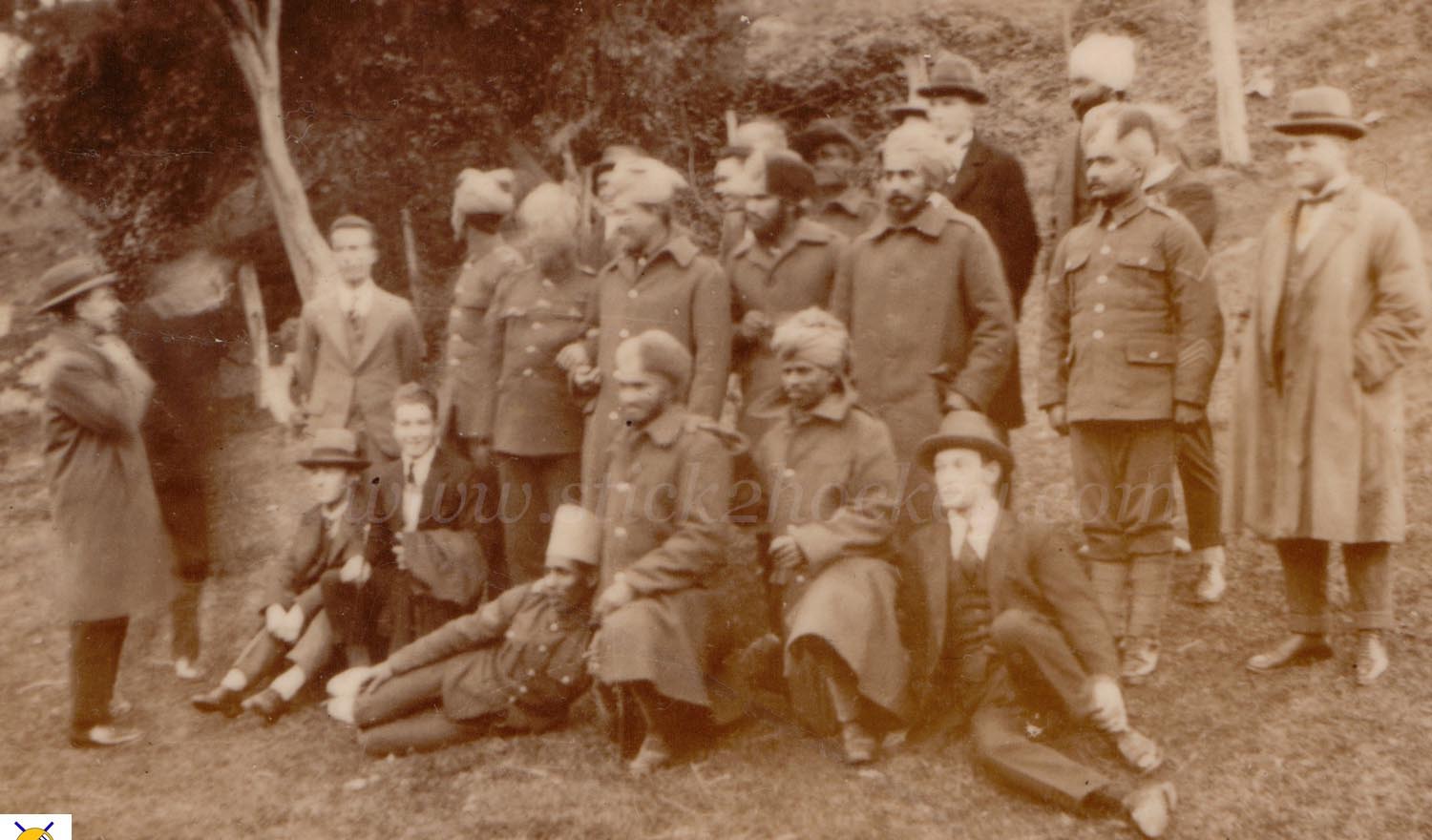
Another day, another setting. Photo: Thakar Singh Family Collection
GK: Ghulan Ali
RB: Kishana Singh
LB: Dhian Singh
RH: Capt. D. T. Cowan (captain)
CH: Fitter Francis
LH: Capt. L. A. Alexander
RW: Sangara Singh
RI: Capt. E.A. Belchamber
CF: Dhyan Chand
LI: Capt. H. V. M. Cox
LW: Susai Nathan.
Dhyan Chand scored three goals with Captain Belchamber and Susai Nathan scoring one each. According to Indian hockey historian K. Arumugam and statistician B.G. Joshi, the test match is classified as full international match. The first test match played on 26 June, 1926, in Christchurch, New Zealand is, therefore, recorded as India’s first international match.
Dhyan Chand scored the first goal, thus becoming the first player to score a goal for India in an international match. Captain David Cowan became India’s first captain at an international match.
The second test match was played on 10 July, 1926, in Auckland with an attendance of over 18,000 spectators. New Zealand won 4–3, after leading 4–1 at half time. Captain Belchamber scoring a hat trick for India.
The third and deciding test match was played on Saturday, 17 July, 1926, in Eden Park, Auckland with an attendance of over 25,000. The match ended in a 1–1 draw. Dhyan Chand scored India’s goal.
Mr. H.S.J. Goodman, president of the New NZHA presented the Indian Army team a handsome silver cup, which was donated by Mr. and Mrs. V.O. Wall through the Hawke’s Bay Hockey Association. The cup is for annual competition between the regiments in India. Dhyan Chand received the cup on behalf of the Indian Army team.
The Indian Army team attracted unprecedented numbers of spectators at hockey matches they played during the tour. The team played 21 matches in New Zealand, won 18, lost 1 and drew 2. They scored 192 goals and conceded only 24. Centre forward Dhyan Chand scored 80 goals. The record of the matches played in New Zealand is as follows: —
1. 13.05.1926: Beat Waipa 11—0.
2. 15.05.1926: Beat Waikato 7—0.
3. 18.05.1926: Beat Auckland Sub-Assn 8–0
4. 20.05.1926: Beat Taranaki 7—2
5. 22.05.1926: Beat Hawke’s Bay 13—2
6. 26.05.1926: Beat Dannevirke 20—0*
7. 29.05.1926: Beat Wanganui 12—1
8. 03.06.1926: Beat Wellington 13—3
9. 05.06.1926: Beat Nelson 9—0
10. 08.06.1926: Beat Buller 9—0
11. 12.06.1926: Beat Canterbury 2—l
12. 17.06.1926: Beat Geraldine 15—0
13. 19.06.1926: Beat Otago 11—0
14. 22.06.1926: Beat South Canterbury 14—2
15. 26.06.1926: Beat New Zealand 5—2
16. 30.06.1926: Drew Manawatu 4-4
17. 03.07.1926: Beat Auckland 11—1
18. 08.07.1926: Beat North Auckland 9—l
19. 10.07.1926: Lost to New Zealand 3—4
20. 14.07.1926: Beat Franklin 13—0
21. 17.07.1926: Drew New Zealand 1-1
* On May 26, the team defeated Dannevirke 20-0. It later transpired “that owing to a mistake of the timekeeper, two spells of 45 minutes each were played, instead of 35 minutes. This gave the visitors an additional 20 minutes in which to show their prowess, and several goals, in both spells, were scored in the extra time”.
A correspondent writing for a Wellington newspaper wrote under the heading “India teaches us Hockey” “From a land of spice and curry it was expected that the Indian Army Hockey team would prove pretty hot. On the contrary they are the coolest customers from a tint country who ever handled hockey sticks. To see them play is to see a fast, concerted, military movement, with kaleidoscopic and scintillating effect. Coloured men, in red, with an occasional top piece of the same colour, they flash about the field with an understanding that beggars description. Two referees cannot keep up with the lightning changes of direction when one of the Indians has hit lustily, full of the knowledge that his team mate is just where he should be. There is no guess work about the Indian players”.
The team left Auckland, New Zealand for Sydney, Australia on 19 July on their return journey and played five friendly matches in Australia before returning home.
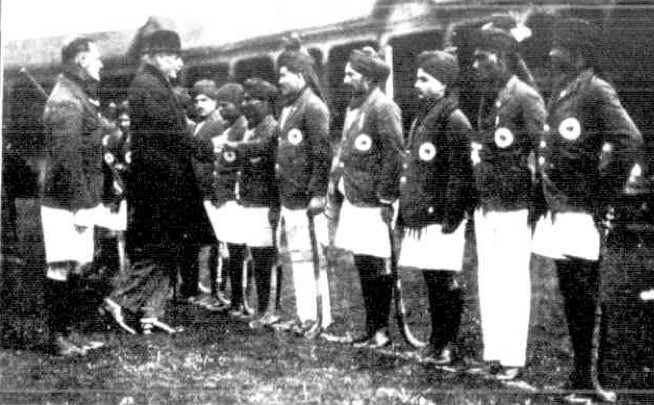
The Governor of Australia, Sir Tom Bridges meeting the team before South Australia match at Adelaide Ova, 5 August 1926. Photo: Australian Indian Historical Society
On Saturday, 24 July, the Indian Army team defeated New South Wales 13-2 in Sydney at the No 2 Ground at Sydney Cricket Ground. Dhyan Chand scored seven goals in this match. On Monday, 26 July, the Indian Army team defeated Royal Military College at Duntroon 14-0. On Tuesday, 27 July, the Indian Army team defeated the Australian Army at Duntroon 14-0. Dhyan Chand scored eight goals in this match. On Saturday, 31 July, they defeated Victoria 7-4 in Melbourne.
In the very last match of the tour, on Thursday, 5 August 1926, the Indian Army team defeated South Australia 14-0 at Adelaide Oval. Dhyan Chand, was given the rare honour of captaining the Army team, which included three officers (unprecedented in those days for a private to captain a team which included officers). Dhyan Chand scored nine goals in this match. The man of the match was left winger Susai Nathan.
Crystal Jordan of the Australian Indian Historical Society, who helped me in my research, gives perspective to the tour as under:
“Despite the White Australia Policy, which was introduced in 1901, Australians in the main have been interested in India and things Indian. This is because of our shared history and both being Colonies of Great Britain. This interest was enhanced by our shared experiences in World War One and was highlighted with the Australian response to the Hon. V. S. Srinivasa Sastri’s tour of Australia in 1922. This tour, which was supported by most Australians, gained equal rights for all Indians living in Australia including the right to vote.
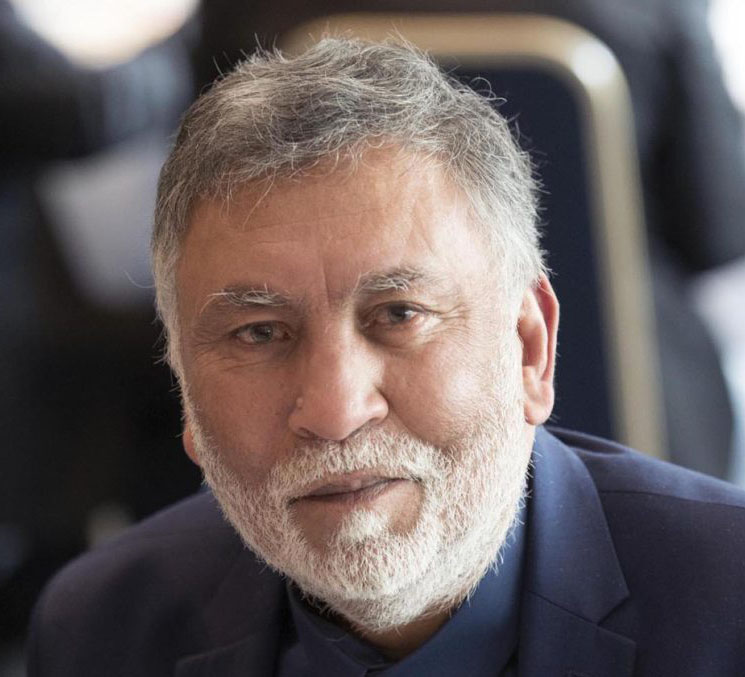
Historian and Author Dil Bahra
The colour and flamboyance of the Indians clad in their scarlet turbans, navy blue blazers with the star of India emblazoned on the pockets, white trousers, and scarlet stockings excited the public imagination, as it did in 1901, when the 100 soldiers of the Indian Contingent arrived in Australia wearing their colourful turbans and army uniforms, to celebrate the Federation of Australia.
The Indian Army Hockey Team was welcomed in Australia because Australia is a sporting country, and any team that visited or visits our shore is welcomed. By competing with the 1926 Indian Army team and subsequent Indian Hockey Teams, Hockey in Australia developed, and this tour laid the foundation for Australia becoming an internationally competitive Hockey playing country”.
At the end of the New Zealand tour, an interesting ceremony was held on July 18 at the Evelyn Firth Home, Parnell. The details of which are given in the link: LINK
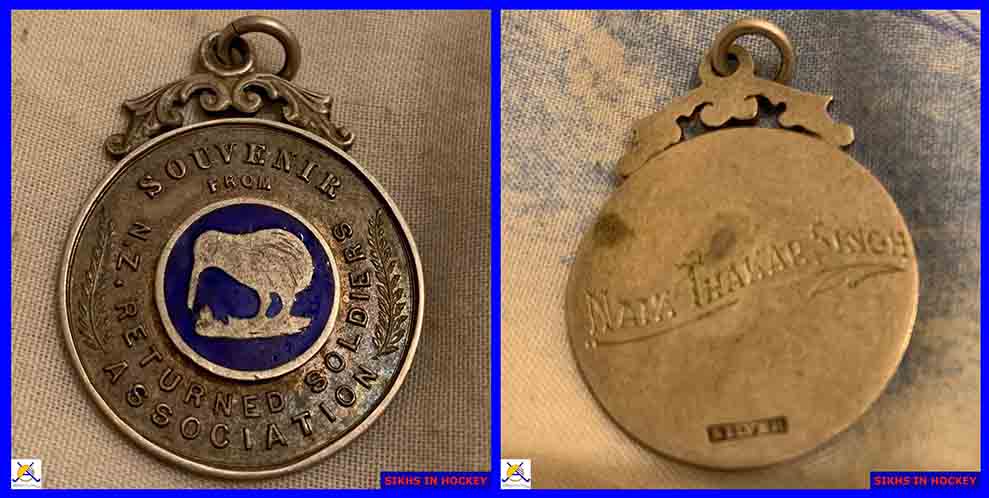
Naik Thakhur Singh Silver Medallion, 1926. Photo: Thakar Singh Family Collection
On their way home to Calcutta, the team played one match in Colombo on 27 August when they beat Ceylon XI 7–2.
The NZHA made a net profit of £1,525 on the tour of the Indian Army Hockey team. Ten percent of this amount went to the New Zealand Association, and the balance was divided among the provincial associations in proportion to the takings at the several centres.

General Cowan, 1945. Photo: Australian War Museum
India’s first hockey captain, David Tennant Cowan MC, who was also the Team Manager on this tour served in the British Indian Army from 1915 – 1947. He rose to the rank of Major General and commanded the Indian 17th Infantry Division in the Burma Campaign during World War 11. Early in 1945, his son, Major Michael Cowan, was killed whilst serving in his old regiment, 1st Battalion, 6th Gurkha Rifles.
He had played hockey to a high standard in England and Scotland, where he was tried for the Scottish team. During the tour, he described Dhyan Chand as “the finest hockey player in the world”. He said that Dhyan Chand was, in his opinion, the only player from this team who was good enough for an All India team.
LEGACY: Sepoy Dhyan Chand of 4/1 Punjab (Jhansi) from this tour was the only player who was selected to represent India at the Amsterdam 1928 Olympic Games. His son, Ashok Kumar, played for India at the Munich 1972 and Montreal 1976 Olympic Games. He also represented India at Barcelona 1971; Amsterdam 1973; Kuala Lumpur 1975 and Buenos Aires 1978 World Cups. Ashok Kumar visited New Zealand with the Indian team in 1975. Naik Thakar Singh’s son, Gurdev Singh, played for India at Melbourne 1956 Olympic Games and captained India at the Jakarta 1962 Asian Games. He visited New Zealand with The Indian Wanderers Team in 1961.
NOTE: This is 5th of the proposed 7-Part Series. The remaining parts will appear shortly

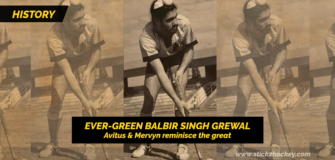

Excellent depiction of historic tour. The author has dug out minutes details. The photos speak for themselves, often it seems taken in off-track locations like sideways, walkways, near bush etc. These photos get us real feeling of the era that had gone by. Thanks everyone for all the good work.
Thank you for your kind comment R S Bhokalia. This was indeed a historical tour and laid the foundation for India’s hockey in international circles. The research also showed that unlike the local Indians living in New Zealand during that period, the Indian Army Hockey Team was treated with utmost respect during the tour. Local Dignitaries, such as mayors and ministers offered cordial welcomes. Their interactions with the local communities and involvement in the Maori culture made them welcome wherever they went.
Amazing history. Proud of Indian hockey. Such article should come on newspapers too
Thank you Natarjan for your kind comment. Your interest in reading these articles is really appreciated.Two more articles to come in this series.
Insightful article as usual, Dil Bahra. There was a wealth of history in it. Had a question. On that tour, did India play twice in Lancaster Park (Christchurch) – the first time on 12th June, 1926 (as per the souvenir guide), and the second time on 26th June, and it is the latter that is considered as India’s first test match.
Thank you P.K Mohan.
Yes, they played twice at Lancaster Park. On the 12th June they played Canterbury and on 26th June the First Test match against New Zealand.
Thanks for your reply, Dil Bahra. A lot of research goes into your articles, and I enjoy the insights that you provide
That was fascinating information about the Indian Hockey tour to Newzealand and Australia in 1926. The goalkeeper of the team Ghulam Ali and (Syed) Lal Shah were from the 106th Hazara Pioneers Indian army. The Hazaras are in fact migrated from Afghanistan to Baluchistan (India) during the civil war of 1892-93 with the Afghan ruler Amir Abdurrahman Khan (1880-1901). Ghulam Ali and Syed Lal Shah and Muhammad Musa (later General Musa Khan, Commander In chief of Pakistan Army during 1965 Indo-Pak war) were selected for the New Zealand tour. Musa Khan dropped from the team due to his selection for military academy Dehradun India. Our record shows that only Ghulam Ali has participated from the Hazara community of Quetta Baluchistan in that Tour. The grandchildren of Ghulam Ali are living in Birmingham UK. it would be great if we could make a reunion party of the ancestry of these legends as a part of community coherent. As a historian and researcher on Hazara soldiery I have a considerable collection of Hazara-Sikh photographs and other relevant information. Nowadays Hazara community in Quetta, Pakistan are facing severe persecution and genocides by the extremist. I really love to share my knowledge and experiences which Hazaras had with the Sikh community had in the past. Thanks again for the information.
Sir, we are extremely grateful for your information. Pl contact me (editor) on my email hockeybook@gmail.com. We can surely write more about them. I looking forward to your reply, regards
Thank you very much for your kind comments and the historical info . As suggested by the editor, please contact him.